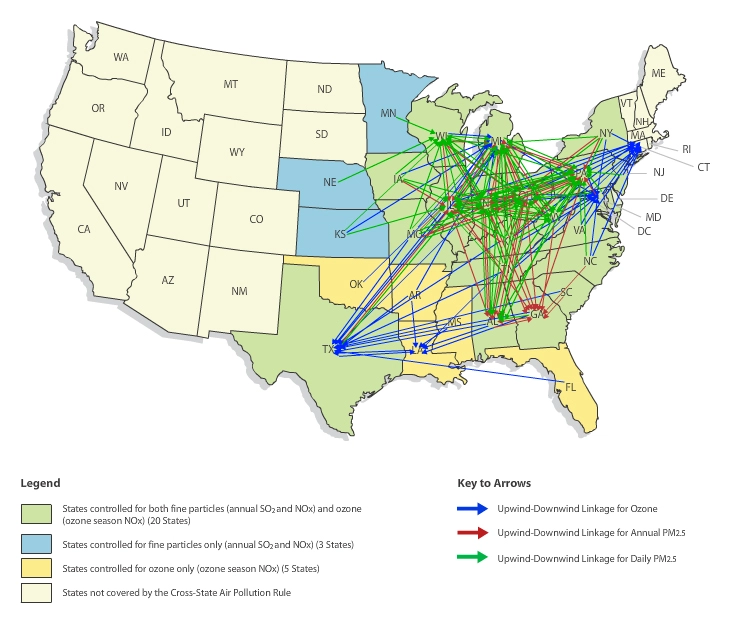by Editorial Staff | April 20, 2016
- Indoor Air
- Outdoor Air
With the release of our 17th annual "State of the Air" report, we've decided to take a closer look at one of the biggest challenges of air pollution. Air pollution just won't stay put! It has no respect for state lines and freely travels wherever the wind takes it. This "transported pollution" can be bad news for people living in states downwind from big pollution sources in other states. Luckily, the Clean Air Act has tools in place to put the brakes on this free-roaming health threat.
To learn more, we talked to Tad Aburn, Director, Air and Radiation Management Administration for the state of Maryland. Maryland, like many states, neighbors other states, with a large number of coal and oil fired power plants, which are high contributors of both of the most harmful and common forms of air pollution, ozone (smog) and particle (soot).
According to Aburn, Maryland has historically had "very high" levels of both ozone and particulate air pollution. However, thanks to the Maryland Healthy Air Act and other emission reduction programs, the state has made great progress over the past five years.
"Reductions in emissions from power utilities, motor vehicles and other sources have reduced the number of days on which Marylanders breathe unhealthy air," said Aburn. "These improvements are the direct result of effective controls on local and regional sources of air pollution. By requiring installation of state of the art control technologies and aggressive policies, we continue to progress toward cleaner air."
Another key to improvements in Maryland is understanding how much pollution is transported from other states.
"We have a very advanced research program that studies how much of our air pollution is coming from other states, using airplanes, balloons and mountain top monitors," explained Aburn. "We found that as much as 70 percent of Maryland's ozone pollution is blowing in from upwind states in the Ohio River Valley. This tells us that we have to view air pollution as a regional issue that can't be controlled by just one state. This is exactly why we need federal controls, like the Cross State Air Pollution Rule (CSAPR) to set standards that require emission reductions over large, multi-state regions."
Image: EPA Map of Upwind and Downwind Linkages Between States
Maryland is not unique. As Aburn explained, many states suffer from transported air pollution, such as Delaware and Connecticut, who may get more than 90 percent of their ozone pollution from other states. This air pollution that travels on wind currents from state to state affects almost every state east of the Mississippi River, often bringing in ozone already above federally mandated limits.
Ozone pollution, which is a powerful lung irritant, is produced when volatile organic compounds and nitrogen oxides, from sources like motor vehicles and power plants, react in sunlight.
"When looking at ozone, we know that for the last three years, Maryland has benefited from a shift in summer wind patterns that are transporting much of the ozone we used to get up into New York and Connecticut," Aburn explained. "But we don't know how long this pattern will last, so we need to keep working to reduce ozone levels across the region. Climate change, which could bring higher temperatures, may also mean more ozone is being created. This would compound the problem and threaten the progress we've made."
Maryland has been very aggressive in controlling pollution that's generated within the state's borders. However, Aburn notes that "robust regional and national programs are needed to support Maryland's efforts."
Regionally, Maryland has been instrumental in bringing together approximately 25 states in the east to see where progress could be made. This collaborative effort with many state air directors and commissioners is looking at new regional control efforts for power plants, vehicles and other sources of air pollution.
A critical national program is the 2011 Cross State Air Pollution Rule (mentioned above) that the U.S. Environmental Protection Agency (EPA) has set up to address transported air pollution. The Cross-State Air Pollution Rule will help avoid tens of thousands of premature deaths and illnesses, and achieve billions of dollars in public health benefits. In November 2015, EPA proposed an update to the cross state rule. A final rule is expected later this year.
We've talked a lot about Maryland, but how is your state doing? Check out "State of the Air 2016" and find out your state's air pollution grades and learn how you can join the American Lung Association to fight against "secondhand smog" and help us all breathe easier!
Blog last updated: October 24, 2025



